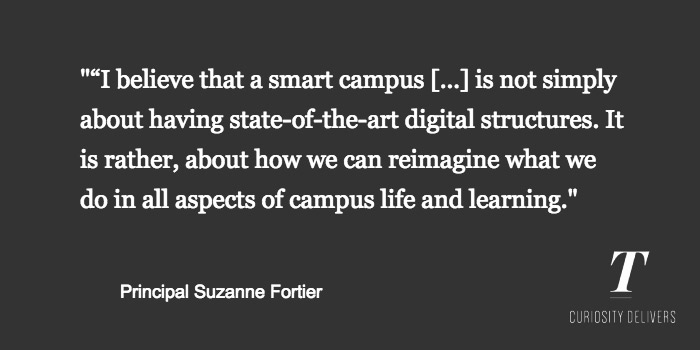Designing a smart campus for the 21st century was the topic of discussion at this year’s annual joint meeting of the McGill Senate and Board of Governors (BoG). The governing bodies gathered this past Tuesday to discuss ways in which McGill could adapt its facilities to suit the needs of both current and future students.
Principal Suzanne Fortier opened the meeting with a description of what it means to be a smart campus.
“I believe that a smart campus […] is not simply about having state-of-the-art digital structures,” Fortier said. “It is rather, about how we can reimagine what we do in all aspects of campus life and learning, and in research and administration, taking advantage of the state-or-the-art technologies that are available to us [….] Our goal is to be more efficient and […] do what we do better, and at the same time save money—that’s the sweet spot that we’d always like to reach.”
The meeting was structured along three points of discussion: Community engagement, technology, and the physical campus related to face-to-face learning. Senate and BoG members were seated at one of 10 tables, with each table assigned one of the three topics during a discussion period.
Community engagement
Students’ Society of McGill University (SSMU) Vice-President (VP) University Affairs Chloe Rourke summarized her group’s findings on how to foster community engagement within McGill.
“The first [suggestion] was to open McGill up to the global community,” she said. “MOOCs and online learning would be an important tool to facilitate that, but also opening our physical campus to the Montreal community through ways like allowing information that is available on campus to be seen through a mobile device, or [having] open lectures.”
Rourke additionally emphasized a need to properly prepare students to contribute back to the community upon graduation.
“In order to allow students to succeed in this changing global environment, you need to provide a supportive environment [for students] to personally develop and grow while at McGill,” she said. “That’s everything from addressing mental health issues to finding opportunities for experiential learning.”
Physical campus and face-to-face learning
Post-Graduate Students’ Society of McGill (PGSS) President Danielle Toccalino suggested the adaptation of McGill classrooms into a more blended and fluid space—a concept that has not traditionally been implemented in the past.
“[This includes] using [classes] as a way to collaborate with peer-based learning and teaching, and taking the actual content of the class to more of an online setting, so you learn outside of the classroom and then come and discuss, collaborate and extend your learning in more social setting,” she said.
Toccalino additionally outlined a need to increase social spaces for students in campus.
“[We should increase] the amount of space that we have on campus where people can come to collect to diffuse after a day in lab or at school and where there’s the opportunity to spark collaboration,” she said.
Technology
SSMU Education Senator Parvesh Chainani highlighted the importance of implementing technology in the classroom.
“Our teaching and learning practices should reflect what students do outside the sphere of the classroom,” he said. “When we go outside we are always on our phones, […] so why not apply that mode of communication into the classroom? Why not use text messages as a medium for students to participate in class?”
Chainani then brought forward an idea to create virtual labs in place of physical ones.
“There isn't much funding to create more laboratories, so why not [have] several universities comes together, pool resources, and create a virtual lab,” Chainani said. “It could be used in the classroom as well because these days in the science classroom, […] your professors teach theory, and they don’t teach how the theory is derived. With a visual medium the students would be able to gain the practical data and apply that to the theory that they learn.”







